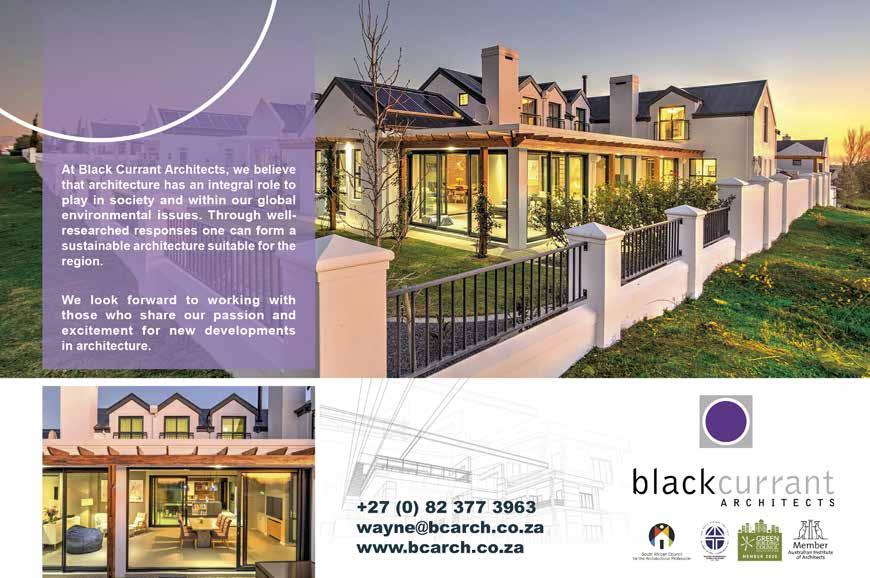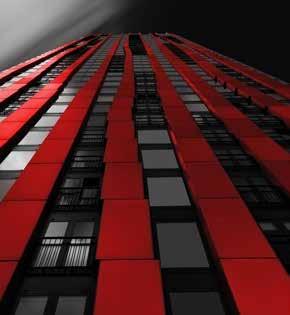
10 minute read
MATERIALS EMBODIED CARBON: AN ARCHITECT’S VIEW Reducing the embodied carbon that goes into the consumption of buildings
Embodied Carbon:
AN ARCHITECT’S VIEW
Advertisement
The built environment is responsible for almost 40% of global climate emissions. Many architects are already designing so that buildings use less carbon in their daily operations. Now it’s time for the second step: to reduce the embodied carbon that goes into the making of those buildings in the first place.

WORDS Lloyd Rubidge, VDMMA
HOUSE KRITZINGER

Looking out over the vineyards of Croydon Vineyard Estate and Table Mountain in the distance this property embodies luxury, style, and comfort. Within the building, windows are placed on both the northern and southern perimeter so the user can enjoy cross ventilation as well as full height sliding glass doors to the outdoors, connecting both the interior and exterior spaces.
The sleek and stylish open-plan kitchen leads seamlessly into the dining room and lounges, which in turn lead onto the patio with wooden decking and a solar heated swimming pool. Built-in fireplaces are strategically placed to add warmth during the colder months where necessary. Interiors are styled with beautiful open trussed ceilings and warm wooden flooring.

Project Details
Location: Croydon Vineyard Estate, Cape Town, South Africa Client: Kritzinger Size: 994m² Status: Built Completion Date: 2018
OPERATIONAL VS EMBODIED
As architects, we know our decisions affect climate change. We spend lots of time and effort thinking about how to light and shade our buildings, how ventilation works and our occupants’ comfort. We do this not only because building regulations require it, but also to create good, usable buildings.
The existing stock of buildings in the world consumes copious amounts of energy: for heating, cooling, lighting and to power the activities of their occupants. This releases huge amounts of greenhouse gasses, mainly carbon dioxide, into the atmosphere. This operational carbon accounts for 28% of all carbon that we humans release, significantly more than the entire transportation sector.
This a shocking amount of carbon, and the reason why we have been increasingly focused on the performance of our new buildings. Around the world, new buildings are improving, and many are achieving close to zero operational carbon. At the same time, many countries and cities are tightening regulations, making that level of performance a requirement.
But that 28% is only part of the story. According to the UN Environment Global Status Report, the world will be building the equivalent of an entire city like New York or Paris every month for the next 30 years. This means the stock of buildings that will produce operational carbon is increasing – and the construction process itself also consumes energy and produces huge amounts of carbon dioxide. This embodied carbon accounts for another 11% of global warming gas emissions.
Think of it this way: every year we increase the world’s building stock, in the process emitting 40% as much carbon as all the buildings already in existence. Over the next decade, as operational carbon emissions continue to fall, embodied carbon will become a bigger part of the problem. But until recently, embodied carbon has been largely ignored.
WHERE TO START?
When I first started thinking about this it seemed to me to be an impossible problem.
The construction industry is geared to build in a certain way, that has changed little over time. Clients, engineers and local authorities have expectations and requirements, and we architects are trying to make beautiful buildings. How can we push against that? Even the construction codes, many of which go back decades, encourage “business as usual”.
Most of us are vaguely aware that some materials are better than others in terms of embodied carbon. Concrete, steel and aluminium, for example, have been long known to be energy-intensive in their manufacture. But is it possible to build without them? And are they really that bad? Is concrete any worse than brick, or a glass curtain-wall? Is a natural tile worse than a manufactured ceramic tile? Where do we even look for information?
CHANGE IS POSSIBLE
We need to bring embodied carbon thinking into our everyday discourse, and every stage of the design process. Can we avoid building in the first place by re-using, refurbishing or extending existing building stock? If we must build new, can we be more efficient, creating smaller buildings that do not waste space or resources and can be more intensively used? This takes a great deal of creativity and design thinking and can make for great architecture.
Then, we need to understand the impact of our design decisions. We should know what products have the highest and lowest global warming potential (GWP) so that we can avoid the worst offenders and encourage the use of better alternatives.
Ideally, we would do a full Life Cycle Analysis (LCA) with a focus on global warming potential for all of our buildings. This may not always be practical, but we can certainly start to interrogate our material choices and incorporate life-cycle thinking into the design process.
Where do we get the information? Can we reasonably ask our suppliers to give us accurate information on the GWP of their products? Would they even know? Right now in South Africa, many salespeople wouldn’t know what you are talking about – but the more we ask, the more aware the industry will become. We have power here.
Internationally, suppliers are increasingly offering products with an Environmental Product Declaration (EPD) that includes a measure of the product’s GWP. These declarations are certified by third parties to ensure that they are comparable and trustworthy.
Until we start to see similar schemes in South Africa, we can use international data from sources such as the Embodied Carbon in Construction Calculator (EC3) tool at buildingtransparency.org
CURRENT TRENDS
Around the world, many of the world’s top architectural practices have signed up to the AIA Architecture 2030 Commitment, the RIBA 2030 Climate Challenge, or the Architects Declare and Construction Declares initiatives. They have made a commitment to take positive action in response to climate breakdown and biodiversity collapse. These commitments include an accelerated shift to low embodied carbon.
Well-known international architects are now sharing their research and their experiences. For example, Heatherwick, AECOM and FCB shared their learnings in a recent article [read below].

EXAMPLE ASSESSMENT
Embodied carbon impact of materials by a UK architect to guide design work.
MATERIAL ALUMINIUM STEEL PVC kgCO2e per m³ 25 650 12 170 4 790
GLASS CONCRETE BRICK CROSS LAMINATED TIMBER (FSC)
Tackling embodied carbon: how to specify the carbon cost of materials
Others, like Norwegian architect Snøhetta, have committed to designing only carbon-negative buildings. Their Powerhouse Brattørkaia office will be carbonnegative over its lifespan.
Architecture firm, Kieran Timberlake released their Revit plugin tool “Tally” to help other architects understand the carbon impact of design decisions, and to compare options.
Architectural associations, institutes and societies are playing their part too. The Boston Society for Architecture recently presented Embodied Carbon 101, making the course available on YouTube [right].
The World Green Building Council has called for all new buildings to have at least 40% less embodied carbon, and all new buildings to emit net zero operational carbon by 2030. The GBCSA’s own Getting to Zero guide [free download on page 74] focuses mainly on operational carbon, but is also working to make embodied carbon accounting more accessible in South Africa.
TAKE ACTION
The embodied carbon in a system, product or material reflects its full life cycle, from mining and manufacturing, installation and maintenance, to demolition, reuse or recycling and disposal. Although complex, some overall assessments can be made, and design decisions can have a significant impact even when full analyses are not practical.
The earlier you start considering embodied carbon in the design process, the bigger the impact. The structure, accounts for a huge proportion of the embodied carbon in a building. In a typical office building shell, concrete and cement can account for about half of the carbon, so the early collaboration between architect and structural engineer is hugely beneficial.
Pixabay

We can also reduce embodied carbon through our selection and specification of materials. One good place to start is Architecture 2030’s Carbon Smart Materials Palette at materialspalette.org , designed to provide “highly impactful guidelines for low/no carbon material selections and specifications”.
DESIGN ETHIC
The impact of climate change is already being felt around the world. We can expect every year to be more volatile, with once-extreme climate events becoming commonplace. It can be easy to feel overwhelmed and powerless – but we cannot give in to the temptation of thinking our personal decisions don’t matter. As architects, we have immense power to shape not only the built environment future generations will inherit, but their whole world. From now on, good design is carbon-conscious design.
In a FastCompany article earlier this year Stephanie Carlisle wrote: “The vision of a radically decarbonised building sector is possible, but only if we all work as if our future depends on it”.
The future depends on us. Will we be able to rise to the occasion?
HIGH-CARBON MATERIALS
CONCRETE Using less cement is the most effective way to reduce the carbon footprint of concrete. Choose suppliers with better GWP ratings, or specify the use of additives and replacements that reduce the amount of cement needed. Optimise structural sizes and spans, and lighten slabs. STEEL The carbon footprint is very dependent on the amount of recycled content. WOOD Unmanaged timber harvesting causes about 25 hectares of forest loss per minute (yes, per minute) globally. Be aware of where timber comes from (if it is not FSC or similar certified there is a good chance it is not from a managed renewable forest). INSULATION There is a huge range. Try to specify products with low carbon, and avoid spray foams and polystyrene where practical. GYPSUM Products with gypsum often have shorter life spans than the building shell, and are rarely recycled. Avoid where possible. CARPET GWP can vary by as much as eight times, so use sources with known GWP. If an Environment Product Declaration (EPD) or similar data is not available locally, use international resources on similar products. Be aware that carpet is likely to be replaced multiple times over the life of a building.
LOW-CARBON MATERIALS
WOOD Use wood from managed sources certified by FSC or another trusted authority. In certain cases you could make the case that you are “sequestering” carbon in the building, removing it from the atmosphere for the life of the building while the replacement forest does the same again. Many countries are changing codes to allow for the structural use of timber, particularly mass timber, like cross laminated timber (CLT). OTHER MATERIALS We can expect more “biogenic” products that can sequester carbon to become available as demand increases. Bamboo, wool, and hemp are examples.
Lloyd Rubidge is a professional architect and co-owner of award-winning South African firm, Van der Merwe Miszewski Architects (VDMMA) . He has worked extensively on high-profile projects, including the Silo District development at the V&A Waterfront in Cape Town, in which several of the buildings achieved 6-Star Green Star ratings.
References and useful resources
https://materialspalette.org/ https://www.fastcompany.com/90435650/these-are-the-last-years-of-design-as-we-know-it http://www.heatherwick.com/studio/news/new-research-tackling-embodied-carbon/ https://aecom.com/without-limits/article/tackling-embodied-carbon-how-to-specify-the-carbon-cost-of-materials/ https://www.dezeen.com/2019/11/27/snohetta-carbon-negative-buildings-pledge/ https://kierantimberlake.com/page/tally https://carbonleadershipforum.org/ https://www.buildingtransparency.org/en/









